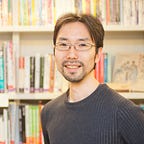Introduction to OSSCafe Studio
Hello, folks. Our studio has been renewed recently, so it’s time to become a videographer! Let me explain how to use our recording equipment. If you’re a member, you can record movie clips as you like. Feel free to use it and ask me about it.
Getting Started
To record your first clip here, you need a SD card or a Mac/Win laptop:
- SD card (8GB or more recommended)
- or Mac/Win laptop (USB 3.0 port required)
In advance, turn on the video switcher and wait a couple of minutes.
Recording with SD card: put your SD card into this device and push REC button. After finished recording, push REC button again. Then you can eject your SD card.
Recording with Mac/Win: no special driver or application needed. Just connect the blue cable (USB 3.0) to your laptop. Our studio system will be recognized as a “standard web camera.” Then, open any application you like. Here’s a list of typical ones:
- QuickTime for Mac
- Camera for Windows 10
- YouTube Studio (beta) through Chrome browser
Tips for Quality
Noise cutting: To reduce the noise on sound, turn them off before recording:
- Wall fan
- Circulator
- Air purifier
- Air conditioner
Lighting: Output needs more light? Change the direction of any spotlight on the wall and ceiling.
After recording, don’t forget to turn the wall fan back on and put the spotlights back to their original position.
Scenes
Typical scene setups would be like these below:
- Scene A: one person (host) with camera 1 and mic 1
- Scene B: two people (host and director) with camera 1, 2 and mic 2
- Scene C: three people (host, guest, and director) with camera 1, 2 and mic 2
- Scene D (presentation): a presenter with camera 2, 4 and mic 1
- Scene E (white back): a host with camera 3 and mic 1
- Scene F (top-down): display something with camera 1 and mic 1
Equipment Overview
Here’s a list of our main tools:
Cameras
- Sony α6000: free position / top-down-camera rig
- Sony α5100: front of the center table (fixed)
- Sony Handycam CX430: front of the white screen (fixed)
- Sony Handycam CX430: front of the 60-inch display (fixed)
Mics
- audio-technica AT2035: on the wall
- audio-technica AT2050: on the center table
We also have a lavalier mic and a headset mic, but these are not connected to mixer usually. You might need to set up by yourself.
Mixers
- Roland V-1HD: a video switcher with four HDMI input
- MACKIE 402VLZ4: a sound mixer
Miscellaneous
- Displays for camera preview and output preview
- Some tripods, a slider, a camera stabilizer
Equipment Details
Some tools have each paticular procedure to power on and off. Check them below:
Roland V-1HD
- Power on: push the power button behind the body. The starting process may take one or two minutes. Check the LCD monitors. If you can’t see anything, push the reset button of the HDMI extender.
- Switching: push center buttons to switch between the cameras. Camera 1 (α6000) / camera 2 (α5100) / camera 3 (CX430) / camera 4 (CX430). See more detail here.
- Power off: push the power button.
Sony α6000
- Power on: remove the lens cover and turn the power nob to “ON.” Then push the shutter button once (I don’t know why…, but it’s needed).
- Shooting position: you can put this camera anywhere you like. There’re some types of tripods which help you. In the case the power cable is short, you might want to use a battery.
- Power off: turn the power nob to “OFF” and put the lens cover back on.
Sony α5100
- Power on: remove the lens cover and turn the power nob to “ON.”
- Power off: turn the power nob to “OFF” and put the lens cover back on.
That’s all! I’m looking forward to watching your great recordings. If you have a question, let me know at the cafe or leave a message on Facebook.
